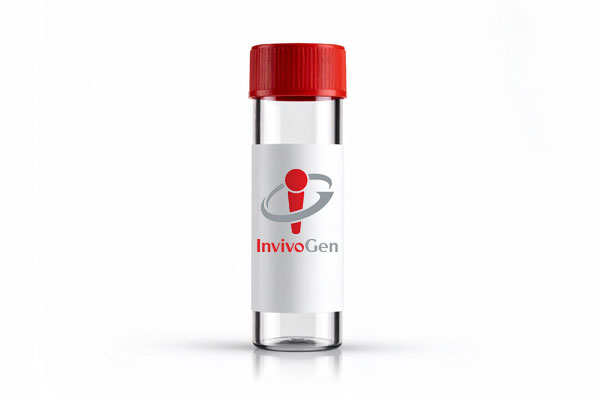HEK-Blue™ hTLR9 Cells
-
Cat.code:
hkb-htlr9
- Documents
ABOUT
NF-κB–SEAP reporter HEK293 cells expressing human TLR9
HEK-Blue™ hTLR9 cells were engineered from the human embryonic kidney HEK293 cell line to study the Toll-like receptor 9 (TLR9)-dependent NF-κB pathway. This important pattern recognition receptor (PRR) recognizes unmethylated CpG dinucleotides, a hallmark of microbial or host-derived self DNA and subsequently triggers NF-κB and IRF immune responses [1].
Description
HEK-Blue™ hTLR9 cells feature the stable expression of the human TLR9 gene as well as an inducible reporter gene for SEAP (secreted embryonic alkaline phosphatase). SEAP levels produced upon TLR9 stimulation can be readily determined by performing the assay in HEK-Blue™ Detection, a cell culture medium that allows for real-time detection of SEAP. Alternatively, SEAP activity may be monitored using QUANTI-Blue™ , a SEAP detection reagent.
HEK-Blue™ hTLR9 cells are highly responsive to TLR9 agonists, such as oligonucleotides containing CpG motifs (CpG ODNs). They show potent NF-κB responses upon incubation of CpG-ODNs of class A (e.g. ODN 2216), class B (e.g. ODN 2006), and class C (e.g. ODN 2395), when compared to their parental cell line HEK-Blue™ Null1 (see figures).
As TLR9 activates both the NF-κB and IRF signaling pathways, InvivoGen also offers HEK-Dual™ hTLR9 cells; a cell line expressing a dual reporter system comprising an NF-κB-inducible SEAP and an IRF-inducible-Lucia luciferase (learn more about HEK-Dual™ cells).
Of note, HEK293 cells express endogenous levels of various PRRs, including TLR3, TLR5, and RIG-I-like receptors, and therefore might respond to their cognate ligands (see figures).
Key features
- Stable expression of human TLR9
- Strong response to synthetic DNA containing CpG motifs
- Distinct monitoring of TLR9-dependent NF-κB activation by assessing the SEAP activities
Applications
- Defining the role of TLR9-dependent NF-κB signaling pathway
- Screening for novel TLR9 agonists and inhibitors in comparison with their parental cell line HEK-Blue™ Null1
- Studying the differences between human and mouse TLR9 when used with HEK-Blue™ mTLR9 cells
1. Kumagai Y. et al., 2008. TLR9 as a key receptor of the recognition of DNA. Adv. Drug. Deliv. Rev. 60(7):795-804.
Disclaimer: These cells are for internal research use only and are covered by a Limited Use License (See Terms and Conditions). Additional rights may be available.
SPECIFICATIONS
Specifications
TLR9
Human
Detection and quantification of TLR9 activity
Complete DMEM (see TDS)
Verified using Plasmotest™
Each lot is functionally tested and validated.
CONTENTS
Contents
-
Product:HEK-Blue™ hTLR9 Cells
-
Cat code:hkb-htlr9
-
Quantity:3-7 x 10^6 cells
- 1 ml of Blasticidin (10 mg/ml)
- 1 ml of Zeocin® (100 mg/ml)
- 1 ml of Normocin™ (50 mg/ml)
- 1 pouch of HEK-Blue™ Detection (cell culture medium for real-time detection of SEAP)
Shipping & Storage
- Shipping method: Dry ice
- Liquid nitrogen vapor
- Upon receipt, store immediately in liquid nitrogen vapor. Do not store cell vials at -80°C.
Storage:
Caution:
Details
Toll-Like Receptor 9 (TLR9)
The Toll-Like Receptor 9 (TLR9) is an endosomal receptor that triggers NF-κB- and IRF-mediated pro-inflammatory responses upon the recognition of unmethylated cytosine-phosphorothioate-guanosine (CpG) forms of DNA [1-3]. Unmethylated CpG dinucleotides are a hallmark of microbial (bacterial, viral, fungal, and parasite) DNA, as well as mitochondrial self-DNA [3,4]. These TLR9 agonists can be mimicked by synthetic oligonucleotides containing CpG motifs (CpG ODNs), which have been extensively studied to improve adaptive immune responses in the context of vaccination [1,3].
TLR9 is mainly expressed in subsets of Dendritic Cells and in B cells of all mammals. In rodents, but not in humans, TLR9 is also expressed in monocytes and macrophages [3]. The structure of the receptor varies by 24% between human TLR9 (hTLR9) and mouse TLR9 (mTLR9) [3]. They recognize different CpG motifs, the optimal sequences being GTCGTT and GACGTT for hTLR9 and mTLR9, respectively [5].
CpG ODNs
Synthetic oligodeoxynucleotides containing unmethylated CpG motifs (CpG ODNs), such as ODN 1018, have been extensively studied as adjuvants [6]. These CpG motifs are present at a 20-fold greater frequency in bacterial DNA compared to mammalian DNA [7]. CpG ODNs are recognized by the Toll-like receptor 9 (TLR9), which is expressed on human B cells and plasmacytoid dendritic cells (pDCs), thereby inducing Th1-dominated immune responses [8]. Pre-clinical studies, conducted in rodents and non-human primates, as well as human clinical trials, have demonstrated that CpG ODNs can significantly improve vaccine-specific antibody responses [6]. Three types of stimulatory CpG ODNs have been identified, types A, B, and C, which differ in their immune-stimulatory activities [9].
![]() Get more information about CpG-ODNs Classes.
Get more information about CpG-ODNs Classes.
References
1. Kumagai Y. et al., 2008. TLR9 as a key receptor of the recognition of DNA. Adv. Drug. Deliv. Rev. 60(7):795-804.
2. Heinz L.X. et al., 2021. TASL is the SLC15A4-associated adaptor for IRF5 activation by TLR7-9. Nature. 581(7808):316-322.
3. Kayraklioglu N. et al., 2021. CpG oligonucleotides as vaccine adjuvants. DNA Vaccines: Methods and Protocols. Methods in Molecular Biology. Vol. 2197. p51-77.
4. Kumar V., 2021. The trinity of cGAS, TLR9, and ALRs: guardians of the cellular galaxy against host-derived self-DNA. Front. Immunol. 11:624597.
5. Bauer S. et al., 2001. Human TLR9 confers responsiveness to bacterial DNA via species-specific CpG motif recognition. Proc Natl Acad Sci USA, 98(16):9237-42.
6. Steinhagen F. et al., 2011. TLR-based immune adjuvants. Vaccine 29(17):3341-55.
7. Hemmi H. et al., 2000. A Toll-like receptor recognizes bacterial DNA. Nature 408:740-5.
8. Coffman RL. et al., 2010. Vaccine adjuvants: Putting innate immunity to work. Immunity 33(4):492-503.
9. Krug A. et al., 2001. Identification of CpG oligonucleotide sequences with high induction of IFN-alpha/beta in plasmacytoid dendritic cells. Eur J Immunol, 31(7): 2154-63.
DOCUMENTS
Documents
Technical Data Sheet
Validation Data Sheet
Safety Data Sheet
Certificate of analysis
Need a CoA ?











